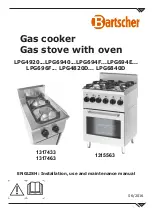
Burner
grates
Cast-iron burner grates should be washed
regularly and, of course, after spillovers.
Wash them in hot, soapy water and rinse with
clean water. Dry the grates with a cloth—don’t
put them back on the cooktop wet. When
replacing the grates, be sure they’re positioned
securely over the burners.
To get rid of burned-on food,
place the grates
in a covered container or plastic bag. Add 1/4
cup ammonia and let them soak for 30 minutes.
Wash, rinse well, and dry.
To prevent rusting,
apply a light coating of
cooking oil on the bottom of the grates.
Although they’re durable, the grates will
gradually lose their shine,
regardless of the
best care you can give them. This is due to
their continual exposure to high
temperatures.
Do not operate a burner for an extended
period of time without cookware on the grate.
The finish on the grate may chip without
cookware to absorb the heat.
Do not use a steel wool pad; it will scratch
the surface.
Clean with hot soapy water. Rinse and dry.
If food soil remains, try a general kitchen
cleaner, such as Fantastik
®
, Simple Green
®
, or
Formula 409
®
.
For hard to clean soil, use a standard stainless
steel cleaner, such as Bon-Ami
®
or Cameo
®
. Soils
can be soaked several hours with wet towels.
Apply cleaner with a damp sponge, rinse
thoroughly, and dry. Always scrub lightly in
the direction of the grain.
Stainless
Steel
Surfaces
(on some models)
After cleaning, use a stainless steel polish, such
as Stainless Steel Magic
®
, Revere Copper and
Stainless Steel Cleaner
®
, or Wenol All Purpose
Metal Polish
®
. Follow the product instructions
for cleaning the stainless steel surface.
Before You Call For Service
Downdraft Gas Cooktop
Questions?
Before you
call for
service…
PROBLEM
POSSIBLE CAUSE
BURNERS DO NOT
• Make sure electrical plug is plugged into a live power outlet.
LIGHT
• Slot in burner base may be clogged. Remove the obstruction.
• Burner parts not replaced correctly.
• Hole in burner cap behind igniter may be clogged.
BURNERS HAVE
YELLOW OR
YELLOW-TIPPED
FLAMES
• If burner flames look like
(A)
, call for service. Normal burner flames
should look like
(B)
or
(C)
, depending on the type of gas.
• Burner parts not replaced correctly.
BURNER FLAMES
• If cooktop is connected to LP gas, contact the person who installed
VERY LARGE
your cooktop or made the conversion.
OR YELLOW
BURNER CONTROL
• When the knob is at the OFF position, it must be pushed in before it
KNOB WILL NOT
can be turned, and it can only be turned in a
counterclockwise
TURN
direction. When the knob is at any other position, it can be turned
in either direction without being pushed in.
FAN DOES
• The vent must be fully extended before fan will work.
NOT WORK
• Fan control knob must be turned in
clockwise
direction to turn
fan on.
A.
Yellow flames:
Call for
service.
B.
Yellow tips on outer cones:
Normal for LP gas.
C.
Soft blue flames:
Normal
for natural gas.
12


































